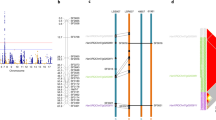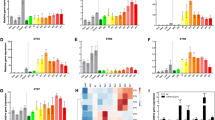Abstract
Ethylene (C2H4) is a gaseous hormone that affects many aspects of plant growth and development. Ethylene perception requires specific receptors and a signal transduction pathway to coordinate downstream responses. The etr1-1 gene of Arabidopsis encodes a mutated receptor that confers dominant ethylene insensitivity. Evidence is presented here that etr1-1 also causes significant delays in fruit ripening, flower senescence, and flower abscission when expressed in tomato and petunia plants. The ability of etr1-1 to function in heterologous plants suggests that this pathway of hormone recognition and response is highly conserved and can be manipulated.
This is a preview of subscription content, access via your institution
Access options
Subscribe to this journal
Receive 12 print issues and online access
$209.00 per year
only $17.42 per issue
Buy this article
- Purchase on Springer Link
- Instant access to full article PDF
Prices may be subject to local taxes which are calculated during checkout
Similar content being viewed by others
References
Abeles F., Morgan, P., and Saltveit, M., Jr., 1992. Ethylene in plant biology. Academic Press, New York.
Ecker, J. 1995. The ethylene signal transduction pathway in plants. Science 268: 667–675.
Schaller, G. and Bleecker, A. 1995. Ethylene-binding sites generated in yeast expressing the Arabidopsis ETR1 gene. Science 270: 1809–1811.
Chang, C., Kwok, S., Bleecker, A., and Meyerowitz, E. 1993. Arabidopsis ethyl-ene-response gene ETR1 similarity of product to two-component regulators. Science 262: 539–544.
Wilkinson, J., Lanahan, M., Yen, H.-C., Giovannoni, J., and Klee, H. 1995. An ethylene-inducible component of signal transduction encoded by Never-ripe. Science 270: 1807–1809.
Lanahan, M., Yen, H.-C., Giovannoni, J., and Klee, H. 1994. The Never Ripe mutation blocks ethylene perception in tomato. Plant Cell 6: 521–530.
Singh, A., Evensen, K., and Kao, T.-H. 1992. Ethylene synthesis and floral senescence following compatible and incompatible pollinations in Petunia inflata. Plant Physiol. 99: 38–45.
Tang, X., Gomes, A., Bhatia, A., and Woodson, W. 1994. Pistil-specific and ethylene-regulated expression of 1-aminocyclopropane-1-carboxylate oxidase genes in petunia flowers. Plant Cell 6: 1227–1239.
Schaller, G., Ladd, A., Lanahan, M., Spanbauer, J., and Bleecker, A. 1995. The ethylene response mediator ETR1 from Arabidopsis forms a disulfide-linked dimer. J. Biol. Chem. 270: 12526–12530.
Bleecker, A., Estelle, M., Somerville, C., and Kende, H. 1988. Insensitivity to ethylene conferred by a dominant mutation in Arabidopsis thaliana. Science 241: 1086–1089.
Theologis, A. 1992. One rotten apple spoils the whole bushel The role of ethylene in fruit ripening. Cell 70: 181–184.
Zarembinski, T. and Theologis, A. 1994. Ethylene biosynthesis and action a case of conservation. Plant Mol. Biol. 26: 1579–1597.
Bleecker, A. and Schaller, G. 1996. The mechanism of ethylene perception. Plant Physiol. 111: 653–660.
Klee, H., Hayford, M., Kretzmer, K., Barry, G., and Kishore, G. 1991. Control of ethylene synthesis by expression of a bacterial enzyme in transgenic plants. Plant Cell 3: 1187–1193.
Richins, R., Scholthof, H., and Shepard, R. 1987. Sequence of figwort mosaic virus DNA (caulimovirus group). Nucl. Acids Res. 15: 8451–8466.
Sanger, M., Daubert, S., and Goodman, R. 1990. Characteristics of a strong promoter from figwort mosaic virus comparison with the analogous 35S promoter from cauliflower mosaic virus and the regulated mannopine synthase promoter. Plant Mol. Biol. 14: 433–443.
Barry, G., Kishore, G., Padgette, S., Kolacz, K., Re, D., Weldon, M., et al. 1992. Commercialization of glyphosate herbicide resistant crops for improved weed control. J. Cell. Biochem. 16(suppl. F): 202.
McCormick, S., Niedermeyer, J., Fry, J., Barnason, A., Horsch, R., and Fraley, R. 1986. Leaf disc transformation of cultivated tomato (L esculentum) using Agrobacterium tumefaciens. Plant Cell Rep. 5: 81–84.
Horsch, R., Fry, J., Hoffmann, N., Wallroth, M., Eichholtz, D., Rogers, S., et al. 1985. A simple and general method for transferring genes into plants. Science 227: 1229–1231.
Yen, H.-C., Lee, S., Tanksley, S., Lanahan, M., Klee, H., and Giovannoni, J. 1995. The tomato Never-ripe locus regulates ethylene-inducible gene expression and is linked to a homolog of the Arabidopsis ETR1 gene. Plant Physiol. 107: 3343–1353.
Clark, D., Richards, C., Hilioti, Z., Lind-lversen, S., and Brown, K. Effect of pollination on accumulation of ACC synthase and ACC oxidase transcripts, ethylene production and flower petal abscission in geranium (Pelargonium x hortorum L. H. Bailey). Plant Mol. Biol. In press.
Author information
Authors and Affiliations
Corresponding author
Rights and permissions
About this article
Cite this article
Wilkinson, J., Lanahan, M., Clark, D. et al. A dominant mutant receptor from Arabidopsis confers ethylene insensitivity in heterologous plants. Nat Biotechnol 15, 444–447 (1997). https://doi.org/10.1038/nbt0597-444
Received:
Accepted:
Issue Date:
DOI: https://doi.org/10.1038/nbt0597-444
This article is cited by
-
Transcriptome analysis of Rafflesia cantleyi flower stages reveals insights into the regulation of senescence
Scientific Reports (2021)
-
Improved leaf and flower longevity by expressing the etr1-1 allele in Pelargonium zonale under control of FBP1 and SAG12 promoters
Plant Growth Regulation (2018)
-
Activating glutamate decarboxylase activity by removing the autoinhibitory domain leads to hyper γ-aminobutyric acid (GABA) accumulation in tomato fruit
Plant Cell Reports (2017)
-
A natural frameshift mutation in Campanula EIL2 correlates with ethylene insensitivity in flowers
BMC Plant Biology (2016)
-
Q&A: How do plants respond to ethylene and what is its importance?
BMC Biology (2016)



